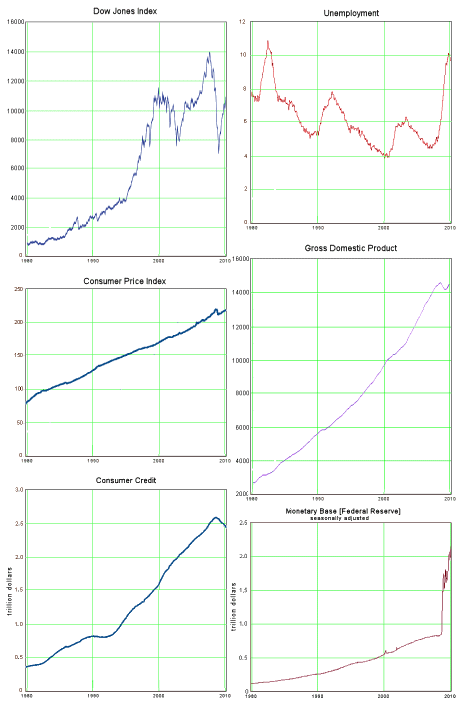Healthcare Reform season seems to be winding down, at least in Congress, and we’re entering the cycle of Financial Reform Legislation. Congressmen Chris Dodd and Barney Frank held a recent Press Conference to roll out their Billl – now out of Committee and headed to the floor of the Congress [over 1300 pages!]. Just perusing the Internet commentary, like Healthcare before it, this Bill is either way too soft or way to harsh – depending on the point of view [and Political Party] of the author. While I’d love to summarize how the Bill addresses the various issues ["too big to fail," derivatives and credit default swaps, "financial bubbles," the national debt, etc], that will have to await people with more skill than I. I’m limited to looking back at what happened this time [way just right…, the parade of my old wedding cake graphs…].
Nate Silver’s site, FiveThirtyEight, Politics Done Right, is the go-to site for any quantitative view of matters politic. There’s a weekly column by Hale Stewart about the economy. This week’s post [A Closer Look At Inflation] looks at whether the Financial Crisis and the response to it is heading us into either an inflationary or deflationary cycle. Using a number of different parameters, he concludes that we’re doing fine [but the commentary is a testimony to how different economists can look at the same data and reach remarkably different conclusions]. Stewart’s post has a lot of data, and is "weedy," but worth a visit if you care about such things. What I took from it was a greater appreciation of the magnitude of what we’ve been through this last 18 months [hopefully the past tense is appropriate].
Our "free market" capitalism goes through cycles – boom and bust. They call it the business cycle and I guess we think of it like earthquakes – stable periods followed by inevitable shifts. – market corrections. But that assumes that it all happens on its own, instabilities in a stable system. We learned in 1929 that there were other possibilities when the system collapsed flat on its face. We added some regulations to keep tabs on things so that wouldn’t happen again. Beginning with the election of Ronald Reagan 50 years after the Great Depression, those regulations were gradually eroded. Reagan’s appointee to the Federal Reserve, Alan Greenspan, deftly regulated the economy primarily by adjusting interest rates at the Federal Reserve [greenspan’s folly…]. We thought he was a wizard until the dam broke in September of 2008. What we would now probably say is that he created an illusion of stability in a system that was increasingly ready to crack.
Stewart’s post pointed me to a few new economic indicators that reinforce the idea that this crisis was not just part of the business cycle. It was one the "big one" [shown with some old friends for comparison]:

In the top row, the Stock Market fell almost 50% from its peak and 6% of our work force lost their jobs. In the second row, there were major tremors in the two major economic indicators never seen in the last thirty year through three other Recessions [in fact never seen since the Great Depression 50 years earlier]. The CPI [measuring Inflation] took an ominous dive and the GDP [measuring our production] had a major wobble. The Monetary Base [lower right] is the amount of liquid cash in the economy, something the Federal Reserve can control in a number of ways, including selling Treasury Notes. Notice the massive infusion of available cash required to stem the decline in our economy. And finally, the graph on the lower left, Consumer Credit, represents all of the credit in the entire country – credit card debt, mortgages, loans, etc. It leveled in the Recessions during Reagan’s and Bush I’s terms. But in this Recession, it has actually fallen significantly.
The bottom two graphs are shown side by side for a reason [in the dimness of my understanding, there’s a point to make]. The fall in Consumer Credit in part reflects the Bank’s reticence to make loans. It’s understandable, they’ve been burned by bad loans and interest rates are really low. But there’s a lot of pressure for them to make more loans. If they do, all that liquid cash being buried in credit would probably send us into an Inflationary cycle – something we really don’t need right now. So, it’s a delicate balance. We need for credit to flow to recover, yet we must to keep Inflation in check to recover [for that reason, I’m not going to have a late career change into matters economic].
Sorry, the comment form is closed at this time.